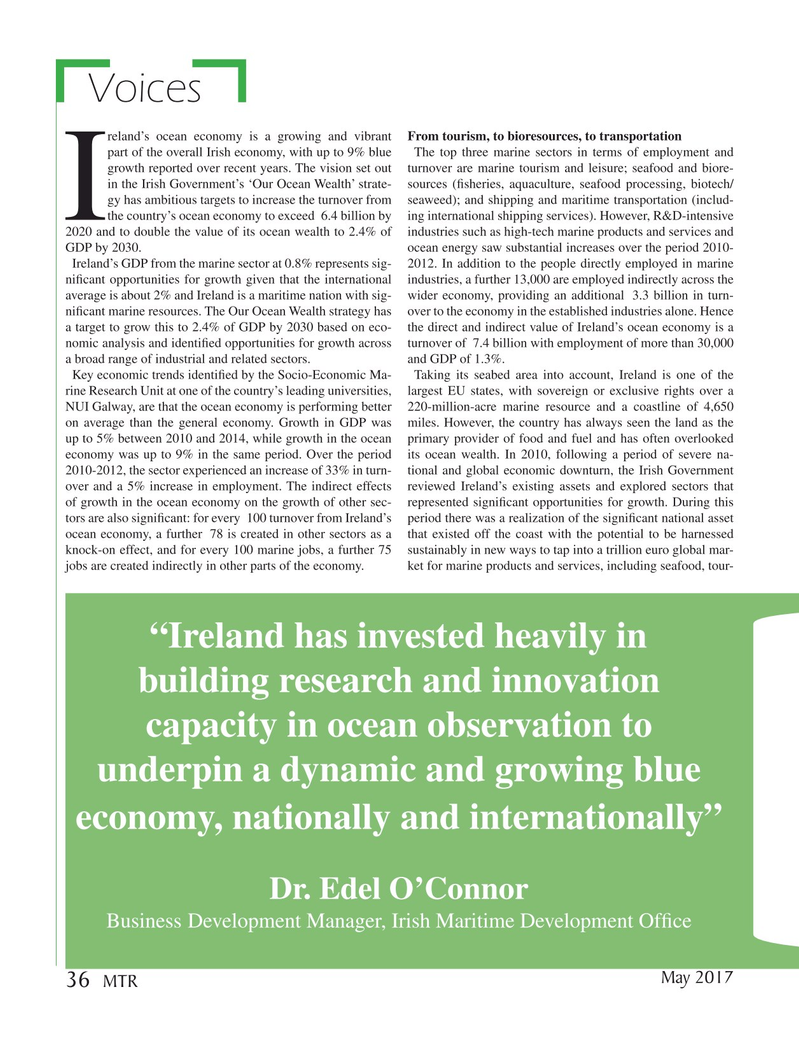
Page 36: of Marine Technology Magazine (May 2017)
Underwater Defence
Read this page in Pdf, Flash or Html5 edition of May 2017 Marine Technology Magazine
Voices reland’s ocean economy is a growing and vibrant From tourism, to bioresources, to transportation part of the overall Irish economy, with up to 9% blue The top three marine sectors in terms of employment and growth reported over recent years. The vision set out turnover are marine tourism and leisure; seafood and biore- in the Irish Government’s ‘Our Ocean Wealth’ strate- sources (? sheries, aquaculture, seafood processing, biotech/ gy has ambitious targets to increase the turnover from seaweed); and shipping and maritime transportation (includ-
Ithe country’s ocean economy to exceed 6.4 billion by ing international shipping services). However, R&D-intensive 2020 and to double the value of its ocean wealth to 2.4% of industries such as high-tech marine products and services and
GDP by 2030. ocean energy saw substantial increases over the period 2010-
Ireland’s GDP from the marine sector at 0.8% represents sig- 2012. In addition to the people directly employed in marine ni? cant opportunities for growth given that the international industries, a further 13,000 are employed indirectly across the average is about 2% and Ireland is a maritime nation with sig- wider economy, providing an additional 3.3 billion in turn- ni? cant marine resources. The Our Ocean Wealth strategy has over to the economy in the established industries alone. Hence a target to grow this to 2.4% of GDP by 2030 based on eco- the direct and indirect value of Ireland’s ocean economy is a nomic analysis and identi? ed opportunities for growth across turnover of 7.4 billion with employment of more than 30,000 a broad range of industrial and related sectors. and GDP of 1.3%.
Key economic trends identi? ed by the Socio-Economic Ma- Taking its seabed area into account, Ireland is one of the rine Research Unit at one of the country’s leading universities, largest EU states, with sovereign or exclusive rights over a
NUI Galway, are that the ocean economy is performing better 220-million-acre marine resource and a coastline of 4,650 on average than the general economy. Growth in GDP was miles. However, the country has always seen the land as the up to 5% between 2010 and 2014, while growth in the ocean primary provider of food and fuel and has often overlooked economy was up to 9% in the same period. Over the period its ocean wealth. In 2010, following a period of severe na- 2010-2012, the sector experienced an increase of 33% in turn- tional and global economic downturn, the Irish Government over and a 5% increase in employment. The indirect effects reviewed Ireland’s existing assets and explored sectors that of growth in the ocean economy on the growth of other sec- represented signi? cant opportunities for growth. During this tors are also signi? cant: for every 100 turnover from Ireland’s period there was a realization of the signi? cant national asset ocean economy, a further 78 is created in other sectors as a that existed off the coast with the potential to be harnessed knock-on effect, and for every 100 marine jobs, a further 75 sustainably in new ways to tap into a trillion euro global mar- jobs are created indirectly in other parts of the economy. ket for marine products and services, including seafood, tour- “Ireland has invested heavily in building research and innovation capacity in ocean observation to underpin a dynamic and growing blue economy, nationally and internationally”
Dr. Edel O’Connor
Business Development Manager, Irish Maritime Development Of? ce
May 2017 36
MTR
MTR #4 (34-49).indd 36 MTR #4 (34-49).indd 36 4/26/2017 12:43:59 PM4/26/2017 12:43:59 PM

 35
35

 37
37
